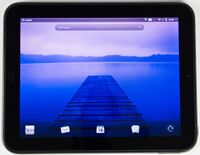HP TouchPad (hp-tenderloin)
 HP Touchpad | |
| Manufacturer | HP |
|---|---|
| Name | Touchpad |
| Codename | hp-tenderloin |
| Released | 2011 |
| Hardware | |
| Chipset | Qualcomm APQ8060 Snapdragon S3 |
| CPU | Dual-core 1.2 GHz Scorpion |
| GPU | Adreno 220 |
| Display | 768x1024 |
| Storage | 16/32 GB |
| Memory | 1 GB |
| Architecture | armv7 |
| Software | |
| Original software | WebOS on Linux |
| postmarketOS | |
| Category | testing |
| Pre-built images | no |
| Mainline | no |
| Flashing |
No data |
|---|---|
| USB Networking |
Works |
| Internal storage |
No data |
| SD card |
No data |
| Battery |
Works |
| Screen |
Works |
| Touchscreen |
Works |
| Multimedia | |
| 3D Acceleration |
Broken |
| Audio |
Broken |
| Camera |
Broken |
| Camera Flash |
No data |
| Connectivity | |
| WiFi |
Works |
| Bluetooth |
Broken |
| Miscellaneous | |
| FDE |
No data |
| USB OTG |
No data |
| HDMI/DP |
No data |
| Sensors | |
| Accelerometer |
No data |
| Magnetometer |
No data |
| Ambient Light |
No data |
| Proximity |
No data |
| Hall Effect |
No data |
| Haptics |
No data |
| Barometer |
No data |
The HP TouchPad is a tablet that originally ran Palm's webOS, although many versions of Android were later ported to it.
Status
Experimental support for this device is available here: https://gitlab.com/postmarketOS/pmaports/-/merge_requests/2791
Contributors
Installation
A detailed installation procedure has yet to be developed, and depends somewhat on what software is currently installed on the device. In summary, the procedure is as follows:
- Delete of shrink one of the existing LVM volumes (such as the Android data partition) by at least 1 GiB (as much space as you want to dedicate to postmarketOS). If you want to retain your data on another OS, you must first shrink the filesystem to avoid corruption. If you want to remove all other OSes, you may delete all LVM volumes.
- Create a 64 MiB LVM volume named "pmos-boot"
- Create a LVM volume named "pmos-root" that fills the rest of the available space.
- Use pmbootstrap to create a split installation and export the files.
- Run the following commands to create an image compatible with moboot or the standard bootloader:
$ mkimage -A arm -O linux -T kernel -C none -a 0x40208000 -e 0x40208000 -n kernel -d vmlinuz uImage.vmlinuz
$ mkimage -A arm -O linux -T ramdisk -C none -a 0 -e 0 -n initramfs -d initramfs uImage.initramfs
$ mkimage -A arm -O linux -T multi -C none -a 0 -e 0 -n postmarketOS -d uImage.vmlinuz:uImage.initramfs uImage.postmarketOS
- Use an environment such as an Android recovery to copy "uImage.postmarketOS", "hp-tenderloin-boot.img" and "hp-tenderloin-root.img" to some temporary storage location on the device.
- Copy "uImage.postmarketOS" into the ext3 filesystem in /dev/mmcblk0p13, usually mounted at /boot in Android. This will only work if you have moboot installed, otherwise the file must be named "uImage".
- Use dd (on the device) to write "hp-tenderloin-boot.img" to the "pmos-boot" LVM volume
- Use dd to write "hp-tenderloin-root.img" to the "pmos-root" LVM volume.
- Reboot the device and select postmarketOS from the moboot menu (if installed).
What works
- Nothing
What doesn't work
- Everything
Progress
- boot.img extracted from Evervolv nightly Android ROM
- determined that boot.img is vmlinuz and not an Android boot image
- successfully compiled novacom (and its dependencies)
Next steps
- package novacom for Alpine
- build device-hp-tenderloin
- find a kernel and compile it
- package kernel and boot image following these instructions
Flashing/booting
It looks like the actual boot process on the touchpad is just uBoot. We only need to package novacom for alpine to push images to the boot partition of the device.
http://webos-ports.org/wiki/Template:Tenderloin_Install_Steps
Novacom sources can be found here. The specific repo and dependencies are as follows:
We can probably use the novacom pkgbuild from the AUR in alpine: https://aur.archlinux.org/packages/palm-novacom-git/
We might also need novacomd, not sure yet.